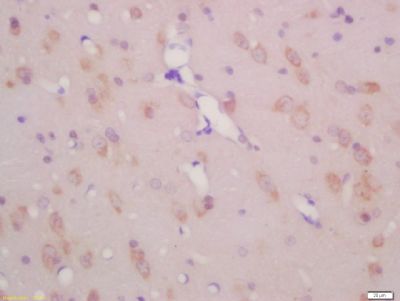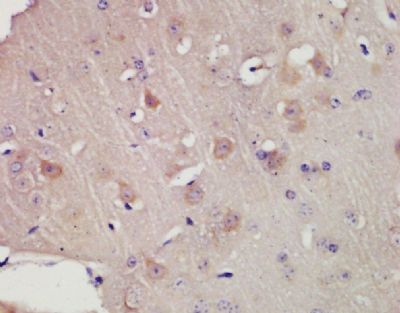KCNC3 Polyclonal Antibody
Purified Rabbit Polyclonal Antibody (Pab)
- SPECIFICATION
- CITATIONS
- PROTOCOLS
- BACKGROUND

Application
| IHC-P, IHC-F, IF, E |
|---|---|
| Primary Accession | Q14003 |
| Reactivity | Rat, Dog, Bovine |
| Host | Rabbit |
| Clonality | Polyclonal |
| Calculated MW | 81 KDa |
| Physical State | Liquid |
| Immunogen | KLH conjugated synthetic peptide derived from human Kv33 |
| Epitope Specificity | 501-600/757 |
| Isotype | IgG |
| Purity | affinity purified by Protein A |
| Buffer | 0.01M TBS (pH7.4) with 1% BSA, 0.02% Proclin300 and 50% Glycerol. |
| SUBCELLULAR LOCATION | Membrane; Multi-pass membrane protein. |
| SIMILARITY | Belongs to the potassium channel family. C (Shaw) (TC 1.A.1.2) subfamily. Kv3.3/KCNC3 sub-subfamily. |
| SUBUNIT | Heterotetramer of potassium channel proteins. |
| DISEASE | Spinocerebellar ataxia 13 (SCA13) [MIM:605259]: Spinocerebellar ataxia is a clinically and genetically heterogeneous group of cerebellar disorders. Patients show progressive incoordination of gait and often poor coordination of hands, speech and eye movements, due to degeneration of the cerebellum with variable involvement of the brainstem and spinal cord. SCA13 is an autosomal dominant cerebellar ataxia (ADCA) characterized by slow progression and variable age at onset, ranging from childhood to late adulthood. Mental retardation can be present in some patients. Note=The disease is caused by mutations affecting the gene represented in this entry. |
| Important Note | This product as supplied is intended for research use only, not for use in human, therapeutic or diagnostic applications. |
| Background Descriptions | The Shaker gene family of Drosophila encodes components of voltage-gated potassium channels and is comprised of four subfamilies. Based on sequence similarity, this gene is similar to one of these subfamilies, namely the Shaw subfamily. The protein encoded by this gene belongs to the delayed rectifier class of channel proteins and is an integral membrane protein that mediates the voltage-dependent potassium ion permeability of excitable membranes. [provided by RefSeq]. |
| Gene ID | 3748 |
|---|---|
| Other Names | Potassium voltage-gated channel subfamily C member 3, KSHIIID, Voltage-gated potassium channel subunit Kv3.3, KCNC3 |
| Dilution | IHC-P=1:100-500,IHC-F=1:100-500,IF=1:100-500,ELISA=1:5000-10000 |
| Storage | Store at -20 ℃ for one year. Avoid repeated freeze/thaw cycles. When reconstituted in sterile pH 7.4 0.01M PBS or diluent of antibody the antibody is stable for at least two weeks at 2-4 ℃. |
| Name | KCNC3 |
|---|---|
| Function | Voltage-gated potassium channel that plays an important role in the rapid repolarization of fast-firing brain neurons. The channel opens in response to the voltage difference across the membrane, forming a potassium-selective channel through which potassium ions pass in accordance with their electrochemical gradient. The channel displays rapid activation and inactivation kinetics (PubMed:10712820, PubMed:16501573, PubMed:19953606, PubMed:21479265, PubMed:22289912, PubMed:23734863, PubMed:25756792, PubMed:26997484). It plays a role in the regulation of the frequency, shape and duration of action potentials in Purkinje cells. Required for normal survival of cerebellar neurons, probably via its role in regulating the duration and frequency of action potentials that in turn regulate the activity of voltage-gated Ca(2+) channels and cellular Ca(2+) homeostasis (By similarity). Required for normal motor function (PubMed:16501573, PubMed:19953606, PubMed:21479265, PubMed:23734863, PubMed:25756792). Plays a role in the reorganization of the cortical actin cytoskeleton and the formation of actin veil structures in neuronal growth cones via its interaction with HAX1 and the Arp2/3 complex (PubMed:26997484). |
| Cellular Location | Cell membrane; Multi-pass membrane protein. Presynaptic cell membrane {ECO:0000250|UniProtKB:Q63959}; Multi-pass membrane protein. Perikaryon {ECO:0000250|UniProtKB:Q63959}. Cell projection, axon {ECO:0000250|UniProtKB:Q63959}. Cell projection, dendrite {ECO:0000250|UniProtKB:Q63959}. Cell projection, dendritic spine membrane {ECO:0000250|UniProtKB:Q01956}; Multi-pass membrane protein. Cytoplasm, cell cortex. Cytoplasm, cytoskeleton. Note=Detected on Purkinje cell dendritic spines, positioned perisynaptically but also in extrasynaptic positions along the spine membranes (By similarity). Detected at presynaptic calices of Held (By similarity). Colocalizes with the cortical actin cytoskeleton and the Arp2/3 complex (PubMed:26997484) {ECO:0000250|UniProtKB:Q01956, ECO:0000250|UniProtKB:Q63959, ECO:0000269|PubMed:26997484} |

Thousands of laboratories across the world have published research that depended on the performance of antibodies from Abcepta to advance their research. Check out links to articles that cite our products in major peer-reviewed journals, organized by research category.
info@abcepta.com, and receive a free "I Love Antibodies" mug.
Provided below are standard protocols that you may find useful for product applications.
If you have used an Abcepta product and would like to share how it has performed, please click on the "Submit Review" button and provide the requested information. Our staff will examine and post your review and contact you if needed.
If you have any additional inquiries please email technical services at tech@abcepta.com.













 Foundational characteristics of cancer include proliferation, angiogenesis, migration, evasion of apoptosis, and cellular immortality. Find key markers for these cellular processes and antibodies to detect them.
Foundational characteristics of cancer include proliferation, angiogenesis, migration, evasion of apoptosis, and cellular immortality. Find key markers for these cellular processes and antibodies to detect them. The SUMOplot™ Analysis Program predicts and scores sumoylation sites in your protein. SUMOylation is a post-translational modification involved in various cellular processes, such as nuclear-cytosolic transport, transcriptional regulation, apoptosis, protein stability, response to stress, and progression through the cell cycle.
The SUMOplot™ Analysis Program predicts and scores sumoylation sites in your protein. SUMOylation is a post-translational modification involved in various cellular processes, such as nuclear-cytosolic transport, transcriptional regulation, apoptosis, protein stability, response to stress, and progression through the cell cycle. The Autophagy Receptor Motif Plotter predicts and scores autophagy receptor binding sites in your protein. Identifying proteins connected to this pathway is critical to understanding the role of autophagy in physiological as well as pathological processes such as development, differentiation, neurodegenerative diseases, stress, infection, and cancer.
The Autophagy Receptor Motif Plotter predicts and scores autophagy receptor binding sites in your protein. Identifying proteins connected to this pathway is critical to understanding the role of autophagy in physiological as well as pathological processes such as development, differentiation, neurodegenerative diseases, stress, infection, and cancer.



